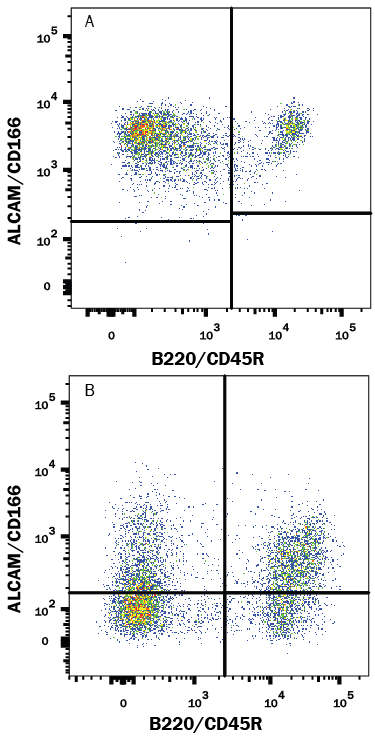Mouse ALCAM/CD166 Fluorescein-conjugated Antibody Summary
Trp28-Lys527
Accession # AAC06342
Applications
Please Note: Optimal dilutions should be determined by each laboratory for each application. General Protocols are available in the Technical Information section on our website.
Scientific Data
 View Larger
View Larger
Detection of ALCAM/CD166 in Mouse Splenocytes by Flow Cytometry. Mouse Splenocytes either (A) activated or (B) resting were stained with Goat Anti-Mouse ALCAM/CD166 Fluorescein-conjugated Antigen Affinity-purified Polyclonal Antibody (Catalog # FAB1172F) and Rat Anti-Mouse B220/CD45R APC-conjugated Monoclonal Antibody (Catalog # FAB1217A). Quadrant markers were set based on control antibody staining (Catalog # IC108F). View our protocol for Staining Membrane-associated Proteins.
Reconstitution Calculator
Preparation and Storage
Background: ALCAM/CD166
ALCAM, activated leukocyte cell adhesion molecule, is a type I membrane glycoprotein and a member of the immunoglobulin supergene family. It is also known as CD166, MEMD, SC-1/DM-GRASP/BEN in the chicken, and KG-CAM in the rat. ALCAM is expressed on thymic epithelial cells, activated B and T cells, and monocytes. ALCAM can bind itself homotypically and is also capable of binding CD6, NgCAM, and other, as of yet, unidentified brain proteins. ALCAM/CD6 interaction may be involved in T cell development and T cell regulation. Additionally, ALCAM/CD6 and ALCAM/NgCAM interactions may play roles in the nervous system. ALCAM has also been observed to be upregulated on highly metastasizing melanoma cell lines and may play a role in tumor migration. ALCAM is a 583 amino acid (aa) protein consisting of a 27 aa signal peptide, a 500 aa extracellular domain, a 24 aa transmembrane domain, and a 32 aa cytoplasmic domain. The extracellular domain of ALCAM contains 5 Ig-like domains of which the amino-terminal V1 domain is essential for ligand binding and ALCAM-mediated cell aggregation (1-4). The ECD of mouse ALCAM shares 97.5% aa sequence identity with rat ALCAM ECD.
- Bowen, M.A. et al. (1995) J. Exp. Med. 181:2213.
- Aruffo, A. et al. (1997) Immunol. Today 18:498.
- Degen, W.G. et al. (1998) Am. J. Pathol. 152:805.
- Van Kempen, L. et al. (2001) J. Biol. Chem. 276:25783.
Product Datasheets
Citation for Mouse ALCAM/CD166 Fluorescein-conjugated Antibody
R&D Systems personnel manually curate a database that contains references using R&D Systems products. The data collected includes not only links to publications in PubMed, but also provides information about sample types, species, and experimental conditions.
1 Citation: Showing 1 - 1
-
Heterogeneity and dynamics of active Kras-induced dysplastic lineages from mouse corpus stomach
Authors: J Min, PN Vega, AC Engevik, JA Williams, Q Yang, LM Patterson, AJ Simmons, RJ Bliton, JW Betts, KS Lau, ST Magness, JR Goldenring, E Choi
Nat Commun, 2019-12-05;10(1):5549.
Species: Mouse
Sample Types: Whole Cells
Applications: Flow Cytometry
FAQs
No product specific FAQs exist for this product, however you may
View all Antibody FAQsReviews for Mouse ALCAM/CD166 Fluorescein-conjugated Antibody
There are currently no reviews for this product. Be the first to review Mouse ALCAM/CD166 Fluorescein-conjugated Antibody and earn rewards!
Have you used Mouse ALCAM/CD166 Fluorescein-conjugated Antibody?
Submit a review and receive an Amazon gift card.
$25/€18/£15/$25CAN/¥75 Yuan/¥2500 Yen for a review with an image
$10/€7/£6/$10 CAD/¥70 Yuan/¥1110 Yen for a review without an image



